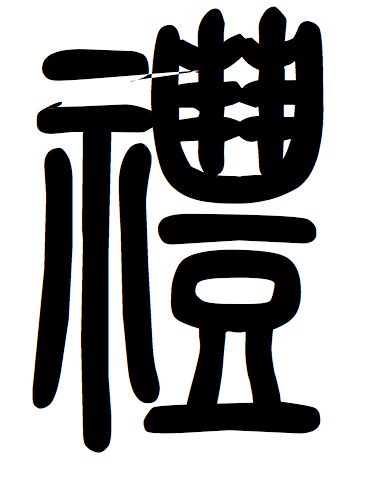Rigid cultural practices are often looked at as inhibiting individual expression but in traditional martial arts “rei” is a way of stepping up into an identity or spirit, working towards goals of self-improvement.

Martial etiquette is a practice with several benefits; “Rei” translates to manifesting the spirit. This is depicted in the seal script character above showing the preparation of an offering of grain for the altar. In Budo or martial arts this is a “do/tao” or Way (big W) of self-improvement, personal growth as an effort toward a larger goal beyond yourself. Rei provides a way to walk the walk in order to understand our own potential. This approach comes out of the Confucius practice of self-cultivation. The self is seen as a tract of land that is tilled, seeded, nurtured and harvested seasonally in a cycle of growth and rebirth.
Martial etiquette as explained in the video is also a way to improve efficiency and reduce conflict. Decisive, purposeful movements that clearly represent your spirit reduce unnecessary effort and ambiguous communication. For the samurai this reserves energy for effective military action but in everyday life that energy is reserved for any challenges along the way.
Lastly, conflict or relational strain is less likely when you are mindful and conscious of your goals and behaviors. Martial etiquette is not about fitting in with high society, it is about recognizing a ladder or path that leads to a larger goal.

The idea of “Rei” is very atypical coming from a collectivist culture. The video gave me a good idea of how martial artists come into themselves – how they are able to reach a better understanding of the self and use that understanding to guide their principles and their choices. I thought that the concept of ‘dignity’ being just as, if not more important than strength, speed, and correctness in performing Sabaki. Since Sabaki encompasses a lot more than just a martial technique, I took this to mean that self-respect and having patience with yourself is critical to the betterment of the self. I was surprised when I read that martial etiquette wasn’t about fitting in with high society – perhaps the respect that the samurai were afforded was more of a byproduct than a primary goal. This is also very different from other martial practices elsewhere in the world – whether talking about strictly a martial art or even martial practice in general (raising an army, etc.), most of the time martial practice is at least in part intended to make the practitioner look tough, like someone who deserves your respect. This is a very self-satisfying goal, not at all like “Rei” as I understand it – I appreciate the idea that through self cultivation, one can achieve respect and reduce conflict.
What I found especially interesting about the etiquette of how an aikido practitioner (or samurai) should follow was the underlying practicality of it. I had always assumed that many of the practices in aikido, such as the way one sits or kneels, existed purely as common courtesies between martial artists. Of course a major part of these practices is to display and maintain mutual respect, but I thought it was incredible how rooted they are in self defense aspects as well. It’s amazing how aikido is truly an art of self defense, right down to the smallest aspects such as the way in which your sit. One thing I’m very curious about is how well these methods can be applied to modern day situations. Maintaining all of these positions and etiquettes is great so long as you’re in a dojo or another equally acceptable place, but does aikido practice any particular etiquettes or stances that are more easily applicable to everyday life in the western world?
What i found intriguing in this video is how aikido and other martial arts participants truly adapt and take on their teachings. That when people take it seriously, they take it to heart and use the teachings in everyday life to better themselves, not for the purpose of defense (or for offense, which is a miss use of the learning’s) but to hold one to a better and higher standard that previously. Like the video states, that etiquette isnt something that a practitioner simply acts out, but has a deeper meaning between his/her environment and fellow people. The one thing during the latter half of the video that peaked my interest is how they state that one has to combine all of the techniques and methods in order to perform the action and movement. And its true, if you go about your day half assing everything and simply walking through the steps in everything one does, you dont really get anything done. I have a lot of my professors and lab professors tell me this on a day to day basis, that i need to stop trying to game the system and actually put in time and energy and thus reap the benefits of what i am learning. This is true for most all things we do and if people took this more to heart, things would get done a lot better and more efficiently.